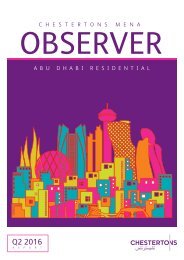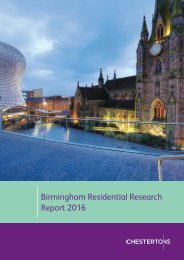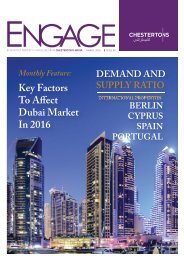Manchester Report
You also want an ePaper? Increase the reach of your titles
YUMPU automatically turns print PDFs into web optimized ePapers that Google loves.
Figure 1: <strong>Manchester</strong> residential sales<br />
14,000<br />
12,000<br />
10,000<br />
8,000<br />
6,000<br />
4,000<br />
2,000<br />
0<br />
2006<br />
2007<br />
2008<br />
2009<br />
2010<br />
2011<br />
2012<br />
2013<br />
2014<br />
2015<br />
Source: Land Registry<br />
An increasing number of people are choosing<br />
to live in the regional centre, with the population<br />
rising from 7,000 in 2001 to 25,000 in 2016.<br />
This trend is set to continue, with around 50,000<br />
new homes anticipated to be needed by 2040.<br />
Household projections and demographic trends<br />
suggest that future demand for flats is likely to<br />
be considerable.<br />
The regional centre housing market is dominated<br />
by flats, sales of which have accounted for over<br />
95% of total sales over the past decade. Flat sales<br />
averaged 2,177 in the period 2006-15, which<br />
includes the years of market downturn following<br />
the global recession. The market has gathered<br />
momentum over the past three years with annual<br />
sales averaging 2,235.<br />
Figure 2: Residential sales v flat sales within <strong>Manchester</strong> regional centre<br />
6,000<br />
5,000<br />
4,000<br />
3,000<br />
2,000<br />
1,000<br />
0<br />
2006<br />
2007<br />
2008<br />
2009<br />
2010<br />
2011<br />
2012<br />
2013<br />
2014<br />
2015<br />
All sales<br />
Flat sales<br />
Source: Land Registry<br />
5















